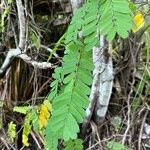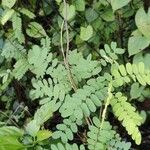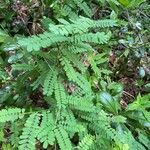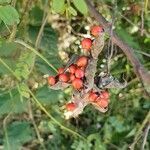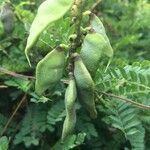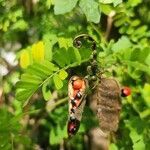Slender vine; stems twining, pubescent with appressed white hairs, glabres-cent. Leaves pinnate with 5-13 pairs of leaflets; leaflets oblong to ovate, mostly 9-15 mm long, 5-7 mm wide, apically rounded or truncate and mucronulate, sometimes acute, basally obtuse, rounded or truncate; petiolules 0.5-1 mm long; petioles shorter than the width of a leaflet; rachis mostly 7-10 cm long, sparingly pubescent with ascending hairs; stipels minute, following the rachis; stipules sub-ulate, 1-2 mm long. Inflorescences leafless pseudoracemes; peduncles stouter than the petioles and often stouter than the stems, 6-10 cm long, bearing ca. 4 pairs of minute bracts along the length; rachis strongly angled, somewhat con-gested, 3-6 cm long, the flowers 1-15 per node, pedicels 1-2 mm long, glabrous except for the apical swelling. Flowers white or pinkish, ca. 1 cm long, calyx cupular, ca. 2 mm long with low teeth, sparingly short pubescent; standard ob-ovate, 8-9 mm long, the wing petals upcurved, ca. 6 mm long, stamens not exserted. Legume oblong, somewhat oblique, ca. 2.5 cm long, 1.5 cm wide,
A climbing vine. It can grow up to 10 m long. The vine can be 1.5 cm thick. The branches are shaped like a rod with small lateral branchlets. The leaves are 5 to 10 cm long and usually smooth underneath. There are 20 to 40 pairs of leaflets. The leaves are like a feather. The leaflets are dull green and much paler beneath and fall off seasonally. The leaflets are 1-2 cm long by 0.3-0.6 cm wide. The flowers stalks are shorter than the leaves. Many flowers are produced on a stalk and they are pinkish white to purple. The pods are oblong and 4-5 cm long. The pods are slightly woody and flattened. They are smooth. They contain 3 to 5 shiny seeds which are bright red with a black spot. The seeds are retained on the pod some time after the pod splits open. The seeds have a very hard coat so are not easily chewed even though they are poisonous. (The poisonous substance must get into the blood stream.)
Lianas. Stem slender, much branched, sparsely white strigose. Leaves paripinnate; leaflets 8-13-paired, opposite; petiolule short; blades suboblong, 1-2 × 0.4-0.8 cm, membranous, sparsely white strigose abaxially, glabrous adaxially, rounded at base, truncate and with mucro at apex. Racemes axillary, 3-8 cm. Flowers small, dense. Calyx campanulate, 4-toothed, white strigose. Corolla purple; standard with triangular claw; wings and keels narrower. Stamens 9. Ovary hairy. Legumes oblong, 2-3.5 × 0.5-1.5 cm, leathery, dehiscent, with 2-6 seeds. Seeds lustrous, black in lower part, red in upper part, subglobose. Fl. Mar-Jun, fr. Sep-Oct.
hardly stipitate, the beak slender, 3-5 cm long, downturned, dehiscent along 1 margin, the valves softly pubescent, compressed but bulging over the seeds; seeds 5-6, subglobose or slightly compressed ovoid, bright shiny scarlet with a black area near the hilum, ca. 6 mm long, the hilum depressed, ca. 1 mm long.
Clustered fruits which burst, exposing the brilliant red black seeds.
Rather stout racemes of pinkish-yellow flowers
A woody twining shrub
